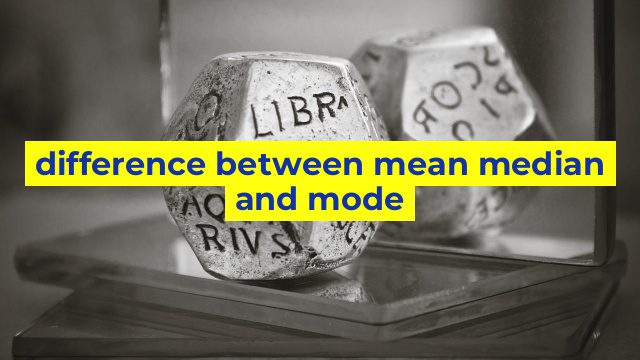Understanding the Difference Between Mean, Median, and Mode
When it comes to statistical analysis, some common terms that people often come across are mean, median, and mode. These terms are used to describe the central tendency of a data set. While all three measures provide useful insights, they differ in how they are calculated and when they should be used. In this article, we’ll take a closer look at each measure and explore the key differences between them.
Mean
The mean is the most commonly used measure of central tendency in statistics. It is calculated by adding up all the values in a data set and dividing the sum by the number of observations. For example, if we have a data set containing the ages of five people: 28, 35, 42, 47, and 56, the mean would be calculated as follows:
28 + 35 + 42 + 47 + 56 ÷ 5 = 40.4
The mean is particularly useful when dealing with symmetrical data sets, where the data is distributed evenly around the mean. However, it can be influenced by outlier values, which may skew the average towards an extreme value.
Median
The median is the middle value in a data set when the observations are arranged in order from lowest to highest. If there are an odd number of observations, the median is the middle observation. For example, if we have a data set containing the heights of seven people: 155cm, 160cm, 170cm, 173cm, 175cm, 180cm, and 185cm, the median would be:
Median = (173cm + 175cm) ÷ 2 = 174cm
The median is useful when dealing with skewed data sets as it is less affected by outliers than the mean. However, it may not accurately represent the central tendency of a data set if there are extreme values.
Mode
The mode is the value that occurs most frequently in a data set. For example, if we have a data set containing the scores of ten students on a test: 65, 70, 75, 75, 80, 80, 85, 90, 90, and 95, the mode would be:
Mode = 75 and 80
The mode is useful when dealing with categorical data or data that has a peak value. However, it may not provide useful insights if each observation in the data set is unique.
In conclusion, while mean, median, and mode are all measures of central tendency, they are calculated differently and have different use cases. The selection of a particular measure depends on the type of data being analyzed and the research question being answered. Understanding these differences can help you to better interpret and analyze statistical data.
Table difference between mean median and mode
| Statistical Measure | Definition | Calculation |
|---|---|---|
| Mean | The average value of a dataset. It gives an idea of the central tendency of the data. | Add up all the values in the dataset and divide the sum by the number of values. |
| Median | The middle value of a dataset. It is the value that separates the data into two equal halves. | Arrange the values in ascending or descending order and choose the value that is in the middle of the dataset. |
| Mode | The value that occurs most frequently in the dataset. It gives an idea of the most common value in the data. | Identify the value that appears most frequently in the dataset. |

